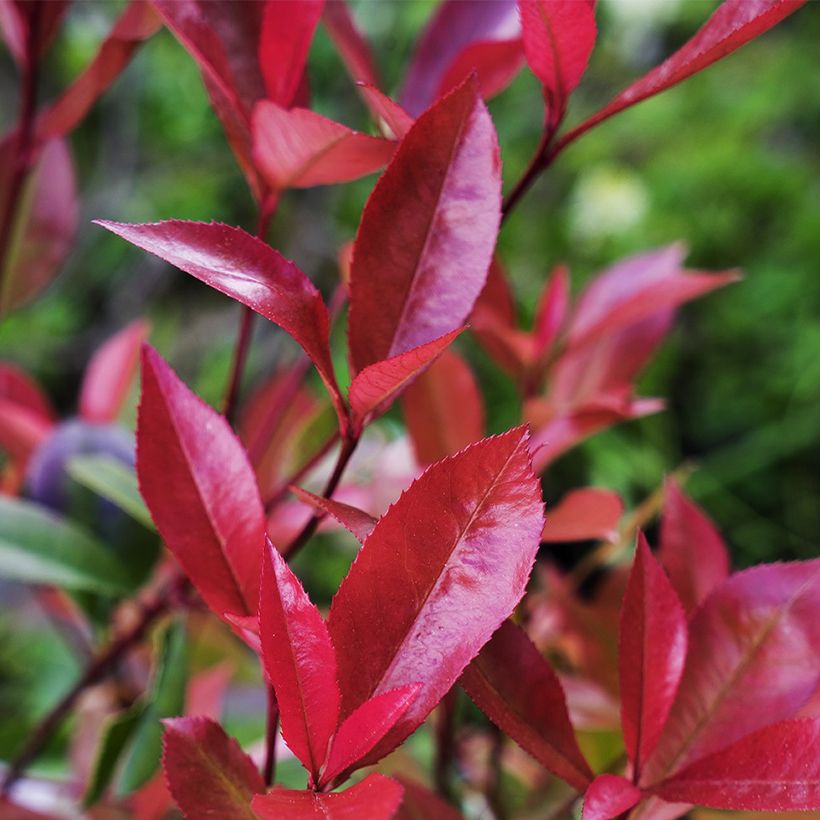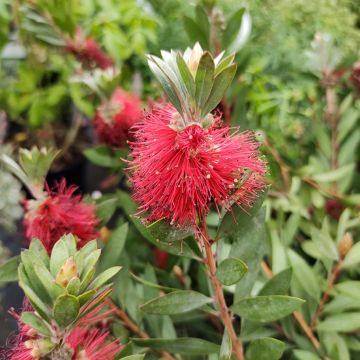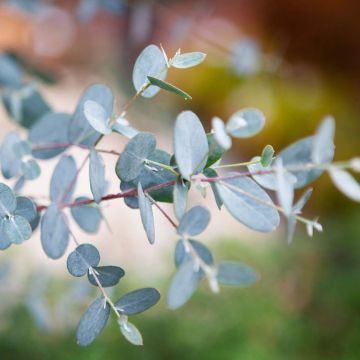

Photinia fraseri Devil's Dream


Photinia fraseri Devil's Dream
Photinia fraseri Devils Dream - Christmas Berry
Photinia x fraseri Devil's Dream
Christmas Berry, Redtip Photinia
Beautiful variety of photinia with very pretty red leaves. I ordered two of them, but one of the two might have a slight disease at the end of summer as its foliage looks a bit strange. The growth is impressive, in a few months they have grown by tens of centimeters.
Marion, 22/09/2024
This item cannot be shipped to the selected country
Delivery charge from €5.90
More information
Schedule delivery date,
and select date in basket
This plant carries a 24 months recovery warranty
More information
We guarantee the quality of our plants for a full growing cycle, and will replace at our expense any plant that fails to recover under normal climatic and planting conditions.
From €5.90 for pickup delivery and €6.90 for home delivery
Express home delivery from €8.90.
Does this plant fit my garden?
Set up your Plantfit profile →
Description
The Photinia Fraseri 'Devil's Dream' has foliage that is finer than the classic Red Robin and, above all, a more upright and compact habit, making it an ideal hedge plant. Its young spring shoots are red and retain their color for longer, only turning green during the summer. In April-May, it produces a flowering of small white-cream corymbs highly appreciated by pollinating insects. In autumn, there is a second highly colored red growth, before the evergreen foliage turns green again during winter. Forming a clump 2.00m (7ft) high and 1.50m (5ft) wide, this beautiful bush can also be planted as a specimen in a bed or even grown in a container as it tolerates pruning very well. Hardy down to -18°C (1°F), it grows in sun or partial shade in most soils and tolerates the atmospheric pollution of our cities well.
The Photinia belongs to the large botanical family of Rosaceae. This family gives us most of our temperate climate fruit trees, (Apple trees, Pear trees, Plum trees, Apricot trees, Peach trees, etc.), but also many ornamental plants (Hawthorn, Cotoneaster, Rose of course, Prunus), as well as numerous wild plants that brighten up our countryside. The Photinia (x) fraseri or Fraser Photinia is an old horticultural creation born in 1940 in the United States, resulting from the cross-breeding between the Photinia glabra, native to Japan, and the Photinia serrulata (or P. serratifolia), native to China. This hybrid has given rise to some famous cultivars, including 'Red Robin', extensively planted in our parks and gardens. In recent years, some beautiful improvements have been made, more compact, more colorful, and more resistant to diseases.
'Devil's Dream' is a German selection by Manfred Behrens, a nurseryman based in Bad Zwischenahn, near Bremen in the north of the country. This variety is very interesting for its distinctly upright habit and its dense and relatively compact growth, perfect for creating single-species hedges or integrating into mixed hedges. Growing about 20-30 cm (8-12in) per year, this shrub reaches a height of 2m (7ft) to 2.50m (8ft) and a width of about 1.50m (5ft). Devil's Dream produces relatively narrow leaves (more than Red Robin), elliptical in shape with a pointed tip (acuminate) and with fine serration around the entire margin of the lamina. At the start of the growing season in spring, the young shoots display the characteristic red color of the species, which is very decorative in hedges or beds. The interest of this variety is that this color lasts longer than in others, until summer. The flowering of small white corymbs of about 5cm (2in) blooms from April to May against this red background, and although not exceptional from a purely aesthetic point of view, it serves to feed pollinating insects, thus attracting biodiversity to the garden.
The mature leaves, which become dark green during summer, give the shrub a second moment of glory in autumn when the foliage flames red once again, rivaling deciduous shrubs with autumnal coloration. Of course, like other varieties of Photinia fraseri, Devil's Dream is evergreen, and turns green again during winter.
Resistant to atmospheric pollution, making it ideal for urban gardens, it also tolerates repeated pruning very well, which, combined with its upright habit, makes it a champion hedge plant. As always, summer pruning, in addition to maintaining the plant's habit, triggers the emergence of red shoots in autumn. In addition to the beautiful color of its foliage, it is also its hardiness and adaptation to all types of well-drained soil that have earned Photinia (x) fraseri worldwide success. Thus, 'Devil's Dream' tolerates all types of well-drained soil, deep, moist to dry, neutral, or even reasonably acidic or alkaline. It particularly thrives in sunny or even partially shaded locations. It is an easy-to-cultivate and easy-to-maintain shrub that can withstand temperatures down to -18°C when exposed to the sun. It is truly the epitome of an easy plant, requiring little maintenance, limited to summer pruning and some watering during hot periods, knowing that once well-rooted, it is quite resistant to drought. Particularly welcome for creating hedges, whether pruned or not, it is also remarkable as a specimen or in beds, and can even be maintained in containers with regular pruning to contain its growth.
This Photinia Devil's Dream will allow you to create superb hedges by combining it with other evergreens with decorative foliage, such as Prunus lusitanica Angustifolia or Portuguese Laurel with narrow leaves, slow-growing but with beautiful glossy green foliage and spring white flowers. For color contrasts, also opt for Elaeagnus pungens Maculata, a Chalef with foliage ranging from yellow to various shades of green and producing lightly scented autumn flowers.
Devil's Dream can also be planted in mixed beds with other evergreen or deciduous shrubs, and perennials along the border. Its red foliage will create a strong contrast with golden shrubs, such as Physocarpus opulifolius Angel Gold or the spectacular Cotinus coggygria Golden Spirit. And in mild climates, create surprise by planting the Eucalyptus Baby Blue next to it, a shrub with astonishing blue foliage.
Report an error about the product description
Photinia fraseri Devils Dream - Christmas Berry in pictures


Plant habit
Flowering
Foliage
Botanical data
Photinia
x fraseri
Devil's Dream
Rosaceae
Christmas Berry, Redtip Photinia
Cultivar or hybrid
Other Photinias
Planting and care
The Photinia fraseri Devil's Dream should be planted in spring or autumn in any deep, moist to occasionally dry, fertile and well-drained soil. It appreciates a sunny or semi-shaded exposure, sheltered from cold and harsh winds. It also tolerates shaded exposures, although this may affect flowering and the intensity of young foliage coloration. Water well for the first two years, once or twice a week, especially during hot and dry weather in summer. Mulch the soil to keep it cool in hot regions, and protect the base in cold regions during the first year in case of severe frost. Once established, Photinia fraseri tolerates summer drought fairly well.
In humid weather or, conversely, in certain dry and poor soils, Photinias can be affected by a fungus (entomosporiosis). If black and red spots appear on the leaves, treat with Bordeaux mixture. The otiorhynchus can also nibble the edges of the leaves at night, while their larvae can attack the roots; treat the soil with nematodes that parasite the larvae.
Planting period
Intended location
Care
-
, onOrder confirmed
Reply from on Promesse de fleurs
Evergreen shrubs
Haven't found what you were looking for?
Hardiness is the lowest winter temperature a plant can endure without suffering serious damage or even dying. However, hardiness is affected by location (a sheltered area, such as a patio), protection (winter cover) and soil type (hardiness is improved by well-drained soil).

Photo Sharing Terms & Conditions
In order to encourage gardeners to interact and share their experiences, Promesse de fleurs offers various media enabling content to be uploaded onto its Site - in particular via the ‘Photo sharing’ module.
The User agrees to refrain from:
- Posting any content that is illegal, prejudicial, insulting, racist, inciteful to hatred, revisionist, contrary to public decency, that infringes on privacy or on the privacy rights of third parties, in particular the publicity rights of persons and goods, intellectual property rights, or the right to privacy.
- Submitting content on behalf of a third party;
- Impersonate the identity of a third party and/or publish any personal information about a third party;
In general, the User undertakes to refrain from any unethical behaviour.
All Content (in particular text, comments, files, images, photos, videos, creative works, etc.), which may be subject to property or intellectual property rights, image or other private rights, shall remain the property of the User, subject to the limited rights granted by the terms of the licence granted by Promesse de fleurs as stated below. Users are at liberty to publish or not to publish such Content on the Site, notably via the ‘Photo Sharing’ facility, and accept that this Content shall be made public and freely accessible, notably on the Internet.
Users further acknowledge, undertake to have ,and guarantee that they hold all necessary rights and permissions to publish such material on the Site, in particular with regard to the legislation in force pertaining to any privacy, property, intellectual property, image, or contractual rights, or rights of any other nature. By publishing such Content on the Site, Users acknowledge accepting full liability as publishers of the Content within the meaning of the law, and grant Promesse de fleurs, free of charge, an inclusive, worldwide licence for the said Content for the entire duration of its publication, including all reproduction, representation, up/downloading, displaying, performing, transmission, and storage rights.
Users also grant permission for their name to be linked to the Content and accept that this link may not always be made available.
By engaging in posting material, Users consent to their Content becoming automatically accessible on the Internet, in particular on other sites and/or blogs and/or web pages of the Promesse de fleurs site, including in particular social pages and the Promesse de fleurs catalogue.
Users may secure the removal of entrusted content free of charge by issuing a simple request via our contact form.
The flowering period indicated on our website applies to countries and regions located in USDA zone 8 (France, the United Kingdom, Ireland, the Netherlands, etc.)
It will vary according to where you live:
- In zones 9 to 10 (Italy, Spain, Greece, etc.), flowering will occur about 2 to 4 weeks earlier.
- In zones 6 to 7 (Germany, Poland, Slovenia, and lower mountainous regions), flowering will be delayed by 2 to 3 weeks.
- In zone 5 (Central Europe, Scandinavia), blooming will be delayed by 3 to 5 weeks.
In temperate climates, pruning of spring-flowering shrubs (forsythia, spireas, etc.) should be done just after flowering.
Pruning of summer-flowering shrubs (Indian Lilac, Perovskia, etc.) can be done in winter or spring.
In cold regions as well as with frost-sensitive plants, avoid pruning too early when severe frosts may still occur.
The planting period indicated on our website applies to countries and regions located in USDA zone 8 (France, United Kingdom, Ireland, Netherlands).
It will vary according to where you live:
- In Mediterranean zones (Marseille, Madrid, Milan, etc.), autumn and winter are the best planting periods.
- In continental zones (Strasbourg, Munich, Vienna, etc.), delay planting by 2 to 3 weeks in spring and bring it forward by 2 to 4 weeks in autumn.
- In mountainous regions (the Alps, Pyrenees, Carpathians, etc.), it is best to plant in late spring (May-June) or late summer (August-September).
The harvesting period indicated on our website applies to countries and regions in USDA zone 8 (France, England, Ireland, the Netherlands).
In colder areas (Scandinavia, Poland, Austria...) fruit and vegetable harvests are likely to be delayed by 3-4 weeks.
In warmer areas (Italy, Spain, Greece, etc.), harvesting will probably take place earlier, depending on weather conditions.
The sowing periods indicated on our website apply to countries and regions within USDA Zone 8 (France, UK, Ireland, Netherlands).
In colder areas (Scandinavia, Poland, Austria...), delay any outdoor sowing by 3-4 weeks, or sow under glass.
In warmer climes (Italy, Spain, Greece, etc.), bring outdoor sowing forward by a few weeks.























































